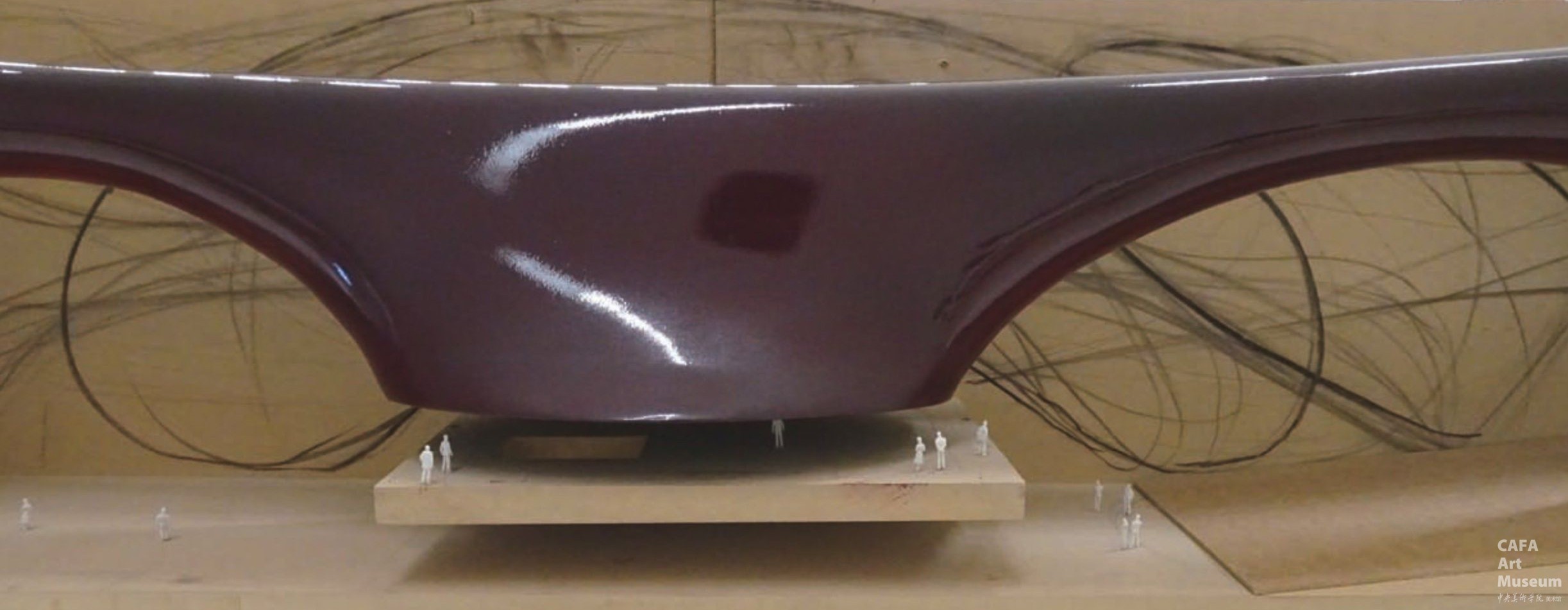
Anish Kapoor的自我检阅
所谓“检阅”,即暗含了数量上、系统上、思想上的阶段完备性,并且具有承前启后的意义,更意指这绝非终点。Anish Kapoor自我检阅的成果即呈现了他完整的艺术的形象,从表面到深层,从幕后到台前。
我们不妨从Anish Kapoor在北京的数次致辞和演讲中提及的“对话”谈起。“对话”既包含倾听与表达的行为,也包括了解和理解的过程。因为展览的两个场地分别是2008年建成的中央美术学院美术馆和拥有六百年历史的太庙美术馆——一个是雪白与自由的当代艺术展示空间,一个是自成一体拥有深厚沧桑历史积淀的明清建筑群,所以Kapoor在处理作品与这两个展场关系的时候,为了取得二者之间适宜的动态平衡,采取了截然不同的姿态。对于与当代艺术同构的当代展览空间,Kapoor将注意力放在充分利用展览空间的形态和表现作品的力势。中央美术学院美术馆内的四件大型装置作品,均经过Kapoor针对展览场地的形状、尺寸与氛围定制和调整而成。例如进入展厅能看到的是大型装置作品《致心爱太阳的交响乐》,这座高达十数米的作品由一轮硕大的“红日”和三条笔直并从不同方向伸向日心的传送带组成,传送带的起点大致位于三角形展览空间的三个角落,而他在柏林的马丁·格罗皮乌斯博物馆展出的同名作品却有四根传送带分别从正方形展厅的四个角引出。另一件作品《远行》是由大面积堆起的红色土山与一辆宝蓝色推土机组成,红色山体绕过展览空间中的隔断墙,以弥漫的方式将作品延伸,令观者可以旁观者的角度从不同的空间以不同视角观察全景或窥其一隅,体会工业与自然、视觉与情感上的对比。这四件大型作品除对物理空间进行特定的“占领”之外,更在作品表现方面展现了他的艺术“野心”与自信。它们的尺度大多在十米的量级,这对于室内陈列的作品和参观者尺度而言均属巨型,而且他积极利用机械和简练的元素,凸显超现实但可浸透体验的场景,并以此触碰观者的心神。例如《我的红色家乡》是机械臂在重达25吨的红色软蜡中旋转画出直径十数米的圆环,在被循环往复搅动的猩红色蜡所形成的肌理间,观者不禁抒发感叹并陷入沉思——工业进程对本地文化冲击和重塑的势不可挡,以及这一过程中个人的渺小与束手无策——这也许正是Kapoor作品那无法抹去的叙事性与象征性之所在。

图1《C-Curve》(摄影:朱羿郎)
相对于中央美术学院美术馆的展览是关于占领空间的表达和创作历程的检阅,在太庙美术馆的分展则更像是他两种作品倾向应战时空对比的纪实。面对历史,Kapoor采用了“谨慎”的对话方式。之所以称作“谨慎”,并非意为Kapoor在太庙的环境中对艺术追求的自我限制,而是意为以细致入微的方式谨慎对待太庙其中的物质与精神元素,在尊重和不影响太庙原有历史厚重的基础上,利用这独一无二的“展厅”条件,以“聪明”的方式展现艺术追求,获得平衡且生动的时空对话。其中正殿部分展出了他的六件镜面不锈钢作品,将镜面作品放置在此殿,是因为这里有绚烂华贵的雕梁画栋,它们是映入他作品所形成的“镜头”里的绝佳素材。Kapoor认为,视觉的变形分为convex(凸变形)、concave(凹变形),以及upside down(上下颠倒)。他的这六件作品,无不以最纯粹的方式将以上三种变形组合编排,所造成的视觉异化是明确的:对参观者而言,例如作品《C-Curve》(见图1),随着走近作品,人们会发现自己从一个上下颠倒的影像逐渐变成硕大的正像,进而又变成正常的正像,这种魔幻的体验在促使人们以运动的方式欣赏作品之余,更促成观者在不同世界中与那个熟悉又陌生的自己对话的冲动;对殿内的历史元素而言,镜面材料反射外界的影像而隐藏了自己的体量与形象,因此身处殿内观者只能从作品的表面看到被二维重塑的殿内的既有影像——褶皱的彩绘、倒挂的编钟等。Kapoor以化解雕塑的“硬”介入的方式纯化场景,从而建立作品与历史景观之间“精巧(delicate)”的关系。而为了保证重塑影像的完整,Kapoor未采纳原先展览主办方提出的在正殿中的作品下面加上台座的建议,坚持以使用黑色微型垫块的方式将作品固定,直接落在经年的既有金砖之上,因此作品反射出的影像是将地面金砖全部囊括在内的殿内全景,而不见与全景不相关的任何元素。纵观这六件作品,与其说是镜面不锈钢雕塑,不如说它们是在大殿历史的全景景象中打开的六个超现实的“窗口”,它们是提供压缩、拉扯、扭动体验的窗口,也是在墙裙中看到天花,在天花中看到金砖的窗口,更是通过当代高技术的变形镜面抛光建立与历史既有对话的窗口。将作品视作“窗口”,而非实体,正是Kapoor“non-object(非物体)”的直接体现,他希望人们不是“看到”他的作品,而是在视觉上透过和超越他的作品。而位于太庙两侧配殿的则是Kapoor深受印度文化影响而创作的带有色粉的作品,包含《1000Names》《Void》《Angles》等名作(见图2)。鲜明的色彩需要配殿明亮的采光和明快的基调,同时配殿内陈设较少,且以白灰幔墙,这为相对强势的雕塑提供了宽松的舞台。Kapoor的色粉雕塑系列,以表现几何体量、方位互动与正负空间为主,颇为自治,它们是配殿中的主角,因此“object(实体)”的力量便予以充分呈现。太庙中所陈列的色粉与镜面系列,一有一无、一实一虚,正如Kapoor所言:“作为艺术家,不得不对空间很敏感。”根据情境,采取恰当的态度,选择适宜的姿态进行对话,这便是对话的“谨慎”所在。

图2 太庙配殿展览 (摄影:朱羿郎)
无论是自我认知还是社会定位上,Kapoor都不仅仅是个雕塑家。在中央美术学院美术馆的展览中,数量可观的建成与未建成的设计模型被一一陈列。它们是模型,也是雕塑,或者说他的雕塑是缩小版的环境设计,他的环境设计是放大版的雕塑,唯一的不同就是模型周边与内部放置了一些示意空间尺度的微缩人、车、树,这便涉及Kapoor在雕塑与建筑景观的领域中往复游离的实践核心——玩转尺度。本华·曼德博的分形理论将“大块头”与“小不点”之间的界线抹平,为建筑景观和雕塑之间的模糊性增添了新的可能。Kapoor认为“雕塑拥有自己的尺度,一件东西之所以成立是因为它有自己的尺度,但尺度与大小无关,而是与其中的内容有关,因此一件东西越有深度和丰富性,他就越大”。尺度问题的化解使得他可以在保持自己艺术思想一贯性的前提下将触角伸向雕塑以外的领域。展览的模型中最引人注目的还是他为芝加哥千禧公园设计的《云门》(见图3)。Kapoor曾表示,《云门》的创作就是玩转尺度的过程,人们在这座逾十米高的巨型公共艺术作品脚下能体会到作品所带来的领域感、压迫感和覆盖感,但如果是在远处看见它,人们又会对它的尺寸表示怀疑——它看起来好像是件很小的雕塑,而Kapoor通过去除尺度指向的材料和施工痕迹做到这种效果——运用航空级的技术,一块一块的不锈钢板被完美焊接并打磨,外表圆润无瑕,平整如镜。此外,尺度上的放大,还给予了人们接近、穿梭、洞见等体验作品的机会,这便给惯常展示外表面的雕塑开辟出了可以大做文章的内表面,更可将内外形象相互协调和对比,甚至相互过渡和融合,更可进一步促成作品从雕塑向公共艺术的华丽转身。《将成为奇特单细胞的截面体》就是这样的例子,从外面看,它是一个简练而冷漠的方盒子,上面分布一些向内凹陷,并向对面开口的管道,作品底部有一洞口允许观者进入。当人们步入其中,却发现内部是错综交错的有机空间,之前提到的管道将外部的光线引入内部,形成动人的明暗关系,与其外表构成巨大差异,这呼应了空间审美上理性几何与感性有机这两种倾向上的对比。而令人诡谲莫辨的是,原先位于外表面“内部”的管道在作品内部看来却成为了空间“外部”的元素,这种内外空间的切换便是内外视角切换的审美价值所在。而像《吻桥》《大地影院》(见图4)《图拉真地铁站》等作品,因其超越了雕塑的基本审美功能而被赋予了明确的桥梁、放映和地铁出入口的实际功能,它们甚至成为了公共空间中形式与功能的又一次辩证。

图3 《云门》(摄影:朱羿郎)

图4 《大地影院》(摄影:朱羿郎)
作为蜚声世界的当代雕塑家,Anish Kapoor以其印度血统、对西方当代艺术的认知、对被感知空间的体悟、对形式语言的追求,以及对社会政治的关注造就了他几何、极简、生命有机,又富有视觉和动线变化的雕塑和装置艺术性格——在空间中舞蹈。而他的空间,不只是弥漫在形体外表面的凹凸进退,也是穿梭在形体内部的黑白序列,更有排除形体的图底虚空。首先与欧几里得的几何相对,Kapoor的主要造型语言是有机形,在作品的凹凸起伏间,生命感与能量感喷薄而出。血管、肌肉、器官等被象征与再现,出现在作品娓娓道来的形式叙事之中,其中最为常见的是与听觉器官相关的有机形式,如耳廓、耳蜗、半规管等,例如陈列在泰特美术馆的《玛尔叙阿斯》(见图5)和位于新西兰Gibbs农场内的《肢解》,其两端放大、中部狭窄的造型均与声音接收和传递相关,这样的题材与他的镜面反射雕塑相配合,从不同侧面凸显其“传导(conduct)”的艺术思路,建立艺术与人、人与人的联络。其次是Kapoor对于空间二元论,即正负形的执念,他将它称之为空间的“男女之分”。他认为人们惯常感知的空间是外显的、正向的、明亮的“男性”空间,但真正的世界是充满矛盾的统一体,那些隐秘的、内向的、幽暗的“女性”空间虽然不常见到或被关注,但并不代表它们不存在,而他的任务之一就是向人们展现这些被忽略却是完整世界补足的空间,这会为人们提供全新的视角,以获得对世界更加均衡的认知。前文提到的《将成为奇特单细胞的截面体》如果从这方面来观察,外表冷峻洗练的背后隐藏着的是一个复杂纠结的内核,它们互相矛盾却被统一在同一个造型之中,这不禁让人与真正的肌体产生联系,因为隆起是生命的表征,凹陷也是,它们互为因果,又相互对比,更富含悸动。

图5《玛尔叙阿斯》(摄影:朱羿郎)
来自Anish Kapoor的检阅
观者慕名而来,旁观Anish Kapoor的自我检阅,但同时因为他的创作历程倾注了他对于艺术的执念,他的作品与生活周遭构成形而上的关系,因此Kapoor自己的检阅注定会在观者身上产生映射,从而激发每个人感同身受的自我检视,这就是“检阅”的第二层含义——这次展览更像是人们接受来自Anish Kapoor的检阅。
作为艺术家,Kapoor为观者树立了“勤勉”的典范。根据Kapoor的描述,“勤勉”的首要原因是,因为当今世界的纷繁芜杂,雕塑无可避免地会传递信息,并会作为催化剂唤起人们由自己的经历生发出来的多元认知,因此在创作之初,大脑需要“勤勉”地认识到这一议题,并以开放的姿态积极地创造信息的发生、传递和接收的途径。其次,Kapoor认为,美永恒存在,并且每一件作品自身具有的美感是它本身就可以完全展现的,并不需要艺术家刻意的阐释。因此,艺术家自身的“勤勉”,是为美感创造新生。第三,艺术的创作是引向未知的过程,Kapoor认为他本人在每一次创作时都没有也不可能预期完成时的模样,更不用说最终的模样会与所处环境的关系、参观者对作品的反应等。例如他提到他这次的数个作品都使用了印度的红色,他将它们带到了中国这个红色的国度,此红与彼红之间就产生了微妙的互动关系,而这种关系是他之前未曾考量过的,这种随机的联姻所带来的惊喜感是他艺术追求的一部分。在这里,“勤勉”的实践便成为了探求与创造无穷未知领域的助推器,得到的馈赠由于不可预知而弥足珍贵。出于上述三个理由,他引出自己对于“勤勉”的看法,那就是保持亢奋,别无他心,就是在工作室工作,工作,再工作。11月11日在中央美术学院美术馆的讲座中,他向人们展示了他工作室中满地密密麻麻的色粉小稿,其中有一些成为了他后来的名作,而更多的只作为艺术思维和技艺的练习,有些甚至不尽如人意,但Kapoor讲到,艺术家无需畏惧失败,但需要使自己“快速地失败”,即不要在某一个失败的地方停留太久,应积极转向后另外尝试。Kapoor是个“勤勉”的开拓者,他认为,对形式、颜色、肌理、材料、运动和技术这六方面的探索可为雕塑找到新的道路,而脑与手的“勤勉”可以保持思考上的敏锐和对未知的挖掘,这便能解释为什么当我们观察Kapoor的三十五年历程的时候,会惊讶于两个展览的四个系列均出自一人之手,仿佛体会到他迎战挑战的游刃有余和积极亢奋的自我批判时“勤勉”的背影。
作为艺术家,除了他没有在创作领域设限之外,也没有将自我认同画地为牢。Kapoor在媒体见面会中回答关于自身认同的问题时提到,他本人虽然出生在印度,但不认为自己仅仅是印度的艺术家,他说在英国这样一个多民族多文化聚集的社会里,他逐渐感到身体中流淌的印度传承是他弥足珍贵的艺术来源,但这与其他文化同等重要,因此他在自己三十五年的创作历程中非常积极地使自己的作品与世界各地的文化相互碰撞与交流,其中既有这次太庙正殿中镜面作品与历史陈列的相得益彰,也有他在凡尔赛宫绿色轴线上的为他招来官司的《肮脏的角落》(见图6),这些对话都很值得,矛盾与统一才是他所谈到的“关爱与包容”的全部,同时这种杂糅也是艺术现代性的体现——抓住文化并超越文化的壁垒,艺术家属于全世界。

图6《肮脏的角落》(图片来自于网络)

图7 Anish Kapoor在媒体见面会现场(摄影:朱羿郎)
Anish Kapoor是积极投身雕塑创作的斗士,当然也是众人仰望的对象,于是本人作为本刊特约通讯员在11月10日下午的媒体见面会上(见图7)向他提出了这样一个问题:“使您成为巨星的成名之作大都是超尺度的和镜面的雕塑,而且您的镜面不锈钢的制作与抛光质量达到了现行技术的极限。当然大尺度和高技性意味着经济实力的强大。你认为这样的大制作和高技性与艺术的本质有什么关系?超级技术与超级的经济力量对于初出茅庐的青年艺术家会意味着什么?雕塑的巨型化和精英化是否是成名的关键?”他的回答确认了雕塑这一门类的固有存在:“这是个非常好但又非常难回答的问题……是的,作为艺术家要做的事情与经济条件,即艺术与商业之间有非常复杂而又奇怪,甚至是非常困难的关系。如果你问我会不会花很多钱让我的作品建立起来,我的答案是肯定的,比如从技术如不锈钢抛光等方面看,的确金钱与艺术是有关系的。但换一个方式看,这种关系总是存在,而我并不是第一人,比如米开朗基罗十六世纪在教堂穹顶上的巨幅绘画,就花费了巨额的资金;再看看曼谷的巨型達堵坡和寺庙,一派镶金带银。如果你问我是否想要看到无产阶级的版本,我当然愿意,但这将是个非常复杂的过程。艺术与经济之间确有复杂关系,因为它关乎两件事情,一个是拥有强大的艺术信仰,另一个就是省钱,但我不理解省钱后的效果会怎么样。”
作者|朱羿郎
原文发表于《雕塑》2019年06期
编辑|郑丽君
参考文献
[1] Anfam, D., Burton, J., Deacon, R.&De Salvo, D. (2010). Anish Kapoor. London: Phaidon.
[2] Kapoor, A. (2010). Anish Kapoor. London: Royal Academy of Arts.
[3] Celant, G. (1996). Anish Kapoor. New York: Thames and Hudson.
[4] Brüderlin, K. (2004). Archi Sculpture: Dialogues between Architecture and Sculpture from the 18th Century to the Present Day. Ostfildern-Ruit: Hatje Cantz Verlag.
